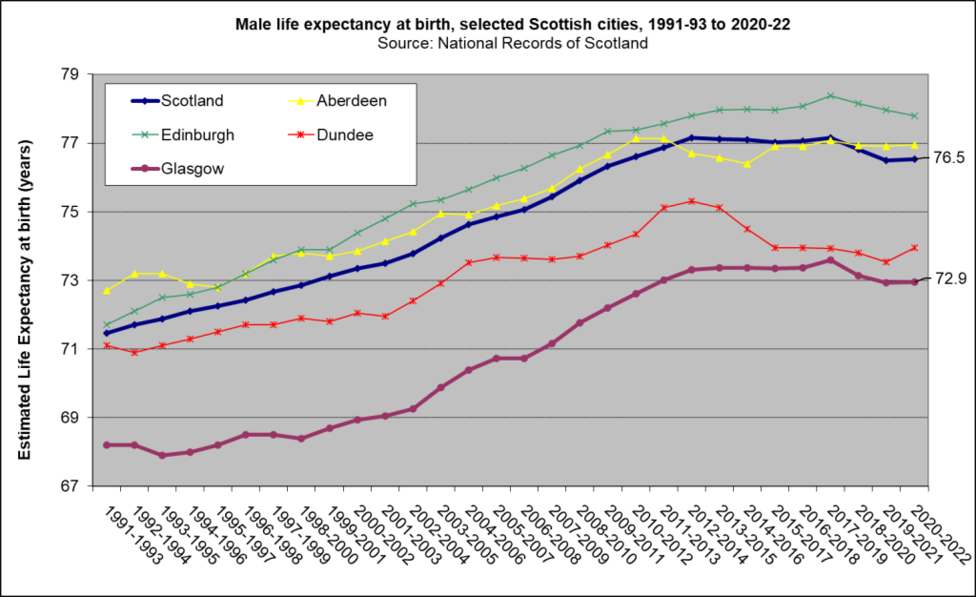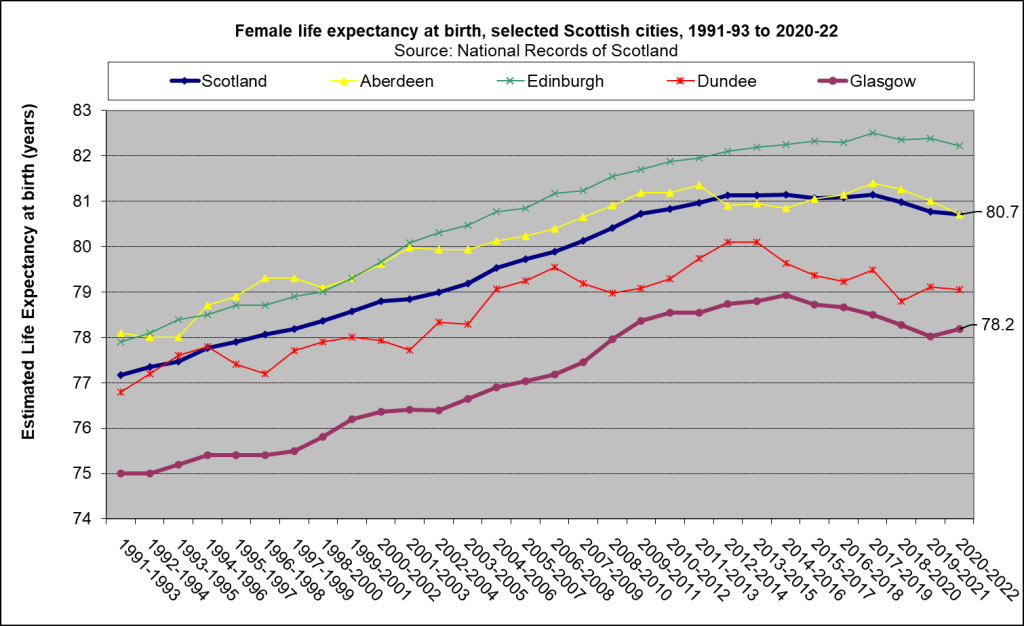Scottish cities
Male life expectancy trends, selected Scottish cities Estimated male life expectancy at birth in Scotland and in its largest cities has increased overall during the last 30 years. However, improvements in life expectancy stalled from 2012 onwards and this is likely to be as a consequence of UK austerity policies. At a Scottish level, there was barely any rise in male life expectancy between 2012-2014 and 2017-2019, while in Scotland's largest cities, male life expectancy trends either flattened off or started to reduce. Increased mortality due to the COVID-19 pandemic, which began in early 2020, has led to a further sharp reduction in life expectancy.
Estimated male life expectancy at birth in Scotland and in its largest cities has increased overall during the last 30 years. However, improvements in life expectancy stalled from 2012 onwards and this is likely to be as a consequence of UK austerity policies. At a Scottish level, there was barely any rise in male life expectancy between 2012-2014 and 2017-2019, while in Scotland's largest cities, male life expectancy trends either flattened off or started to reduce. Increased mortality due to the COVID-19 pandemic, which began in early 2020, has led to a further sharp reduction in life expectancy.
There have been persistent differences, or inequalities, in life expectancy across Scotland. Life expectancy in Glasgow is lower than in other Scottish cities. In 2020-22, a boy born in Glasgow was estimated to be likely to live to 72.9 years, 4.7 years longer than in the early 1990s but 3.6 years shorter than in Scotland as a whole.
It is notable that Dundee's position has become relatively worse: in 1991-93 male life expectancy in Dundee was only marginally lower than the Scottish average, by 2020-22 male life expectancy was 2.5 years lower than the Scottish average.
Female life expectancy trends, selected Scottish cities Female life expectancy in Scotland and in its largest cities has increased over the last 30 years but, as for men, the upward trend in life expectancy flattened off from 2012 onwards and there have been reductions in life expectancy in some cities. In the most recent period shown, 2022-22, increased mortality due to the COVID-19 pandemic, which began in early 2020, has led to a further reduction in life expectancy.
Female life expectancy in Scotland and in its largest cities has increased over the last 30 years but, as for men, the upward trend in life expectancy flattened off from 2012 onwards and there have been reductions in life expectancy in some cities. In the most recent period shown, 2022-22, increased mortality due to the COVID-19 pandemic, which began in early 2020, has led to a further reduction in life expectancy.
Estimated female life expectancy in Glasgow has increased by 3.2 years over the last 30 years but is still lower than in other Scottish cities. In 2020-22, a girl born in Glasgow was estimated to be likely to live to 78.2 years, an average lifespan that is 2.5 years shorter than in Scotland as a whole. Similarly to men, there have been reductions in life expectancy among women in Dundee and Glasgow, and to a lesser extent in Aberdeen in the last three to five years.
Since 2012-14, female life expectancy has reduced in Scotland and in three out of four of Scotland's major cities.The impacts of both austerity policies – and, since 2020, of COVID-19 – are notable in this period.
Notes
The data underlying these graphs come from National Records of Scotland.
In August 2021 the GCPH published Health in a changing city: Glasgow 2021, a report that examined demographic, socio-economic, environmental and health trends in Glasgow over the last two decades and trends in life expectancy by neighbourhood and by deprivation were included.
Research on the impact of austerity on mortality and life expectancy can be accessed on the GCPH website. The most recent paper on the likely impact of UK austerity policies was published in October 2022: ‘Bearing the burden of austerity: how do changing mortality rates in the UK compare between men and women?
This page was last updated in October 2023.
